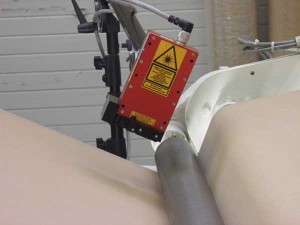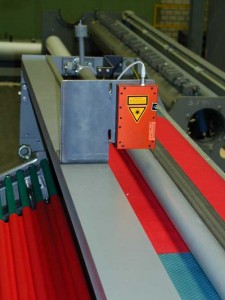For tough materials:
State of the Art Machine Calibration
Non-woven, fleece, felt plus composites based on these materials are in increasing demand. Applications for these materials are expanding and manufacturers are increasingly required to produce diverse composite materials. European manufacturers are well equipped with modern and efficient machinery for this trend. But for those who are entrusted with the measurement and billing of the production, the different nature of materials poses a significant challenge. Each uncounted sold running meter and material which is damaged by pressure marks means loss. Furthermore conventional tactile measurement procedures often do not meet the European Measurement Instruments Directive (MID 2004/22/EC) requirements.
The following article describes the laser based, non-contact ELOVIS μSPEED system which solves these problems.
More exact, by Laser
TWE Dierdorf GmbH & Co. KG is a typical manufacturer with the above situation. TWE produces high quality fleece for the automotive, health and construction industry. Since 2011, all machine counters are calibrated regularly with the ELOVIS non-contact laser-based speed and length measurement systems. “To calibrate our machines, which produce difficult to measure products, we needed a reliable and easily deployable measurement technology. We can now sincerely recommend the ELOVIS laser-based sensors”, says Wolfgang Schoop from the QA department. « Strips and pressure marks on the material surface and thus waste during the calibration measurement are avoided with the laser. The laser measurement is independent of the material and enables permanent high accuracy measurements. » Edith Müller (QA-manager) adds, “In addition, the use of non-contact length measurement quickly shows where an action point is and where the laser technology should replace a tactile measurement system. Non-contact means no wear and no down time for maintenance thus lowering operating costs. »
“Current tactile methods often reach their technical limits already below 40 m/min or as soon as a material change occurs”, explains Bernd Engelsdorf, managing director of ELOVIS GmbH, Karlsruhe, Germany. “The non-contact µSPEED sensors use specific doppler method, developed by ELOVIS and certified by the German national metrology institution (PTB, Braunschweig) in compliance with the European Measurement Instrument Directive (MID 2004/22/EC). The optical sensor is advantageous because it has no speed limitation, operates independent of the material and has no effect on the measured object.” These were decisive factors for TWE. By means of non-contact length measurement the calibration of the measurement devices now is much quicker, easier and more accurate despite elastic materials and varying thickness.
State of the Art – Machine Calibration
 In practice, the calibration of a machine counter is performed with the standalone μSPEED sensor as a parallel measurement. Installation and adjustment of the sensor takes less than 5 minutes due to suitable aids, which also avoid misalignment and thus measurement errors. By comparing the counter value before, during and after the creation of a material roll on the one hand, the absolute deviation in length and on the other hand through multiple measurements the repeatability of the machine counter is determined. Driving the system at different speeds and accelerations, the influence of these parameters on the accuracy of the system counter can be determined as well. Finally running of goods with different thickness, structure, elasticity, … on the machine during calibration, gives a clear picture of the performance of the existing machine counters. The adaptation of the counter is made accordingly, if possible. Via a PC/laptop or an external display or operating unit, the measured values can be displayed, studied, stored and processed. The error-prone archiving of documents is avoided. Instead the measured values are stored in a machine calibration file. “Independence of the μSPEED sensor to material, thickness, colour, coating, line speed, acceleration and with a longterm stable accuracy of better than +/- 0.5 meters at 1,000 meters measured length, the method is far superior to conventional alternatives”, adds Bernd Engelsdorf.
In practice, the calibration of a machine counter is performed with the standalone μSPEED sensor as a parallel measurement. Installation and adjustment of the sensor takes less than 5 minutes due to suitable aids, which also avoid misalignment and thus measurement errors. By comparing the counter value before, during and after the creation of a material roll on the one hand, the absolute deviation in length and on the other hand through multiple measurements the repeatability of the machine counter is determined. Driving the system at different speeds and accelerations, the influence of these parameters on the accuracy of the system counter can be determined as well. Finally running of goods with different thickness, structure, elasticity, … on the machine during calibration, gives a clear picture of the performance of the existing machine counters. The adaptation of the counter is made accordingly, if possible. Via a PC/laptop or an external display or operating unit, the measured values can be displayed, studied, stored and processed. The error-prone archiving of documents is avoided. Instead the measured values are stored in a machine calibration file. “Independence of the μSPEED sensor to material, thickness, colour, coating, line speed, acceleration and with a longterm stable accuracy of better than +/- 0.5 meters at 1,000 meters measured length, the method is far superior to conventional alternatives”, adds Bernd Engelsdorf.
 Machines requiring obligatory calibration and those with inaccuracies caused by material variations or due to slippage for example are best equipped with a permanently laser sensor. The sensor provides direct exchange of data with the operational data collection and allows receipt, label, logo, product data and barcode printing. When used for cutting tasks, prefix lengths can be created, so that the sensor outputs signals for precontact/braking ride and stop/cut.
Machines requiring obligatory calibration and those with inaccuracies caused by material variations or due to slippage for example are best equipped with a permanently laser sensor. The sensor provides direct exchange of data with the operational data collection and allows receipt, label, logo, product data and barcode printing. When used for cutting tasks, prefix lengths can be created, so that the sensor outputs signals for precontact/braking ride and stop/cut.
From November 2016 on, the type-approval for length measurement systems is no longer valid, even if the old certificate is said to be valid indefinitely. This means action is needed for companies who are selling their products by length. The respective regional verification office (or notified body) will accept from November 2016 only those length measurement machines which meet the Measurement Instruments Directive of the European Community according to MID 2004/22/EC.
Even if there is no legal obligation forcing calibration, composite and non-woven manufacturers and their customers benefit from the non-contact length measurement. Bernd Engelsdorf comments, « Beyond the pure fulfillment of legal requirements, the use of calibrated measurement instruments creates customer confidence and transparency in production planning and control. »